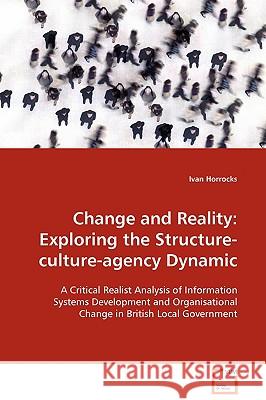Change and Reality: Exploring the Structure-culture-agency Dynamic » książka
Change and Reality: Exploring the Structure-culture-agency Dynamic
ISBN-13: 9783639094213 / Angielski / Miękka / 2008 / 328 str.
Change and Reality: Exploring the Structure-culture-agency Dynamic
ISBN-13: 9783639094213 / Angielski / Miękka / 2008 / 328 str.
(netto: 336,54 VAT: 5%)
Najniższa cena z 30 dni: 353,37
ok. 10-14 dni roboczych
Bez gwarancji dostawy przed świętami
Darmowa dostawa!
Since the early 1990s information systems (IS) have increasingly pro-vided both the technical platform and conceptual rationale for ongoing and widespread institutional and cultural change across government and public services worldwide. However, analysis tends to shy away from examining the complex dynamic between agency (individual actors and collectivities), structure (systems, institutions, roles, positions), and culture (ideas, theories, beliefs and values) that is integral to these developments. Instead agents and structures are conflated - treated as largely epiphenomenal to each other. This book argues for a different approach informed by critical realism and acceptance of the principle of analytical dualism. By so doing it demonstrates how cycles of IS development and organisational change are conditioned, shaped, trans-formed and reproduced over time by the agency/structure dynamic, leading ultimately to complex and highly variable outcomes. In short, although British local government based, this book should be of interest to many scholars and professionals working in government and public administration and IS and management.
Since the early 1990s information systems (IS) have increasingly provided both the technical platform and conceptual rationale for ongoing and widespread institutional and cultural change across government and public services worldwide. However, analysis tends to shy away from examining the complex dynamic between agency (individual actors and collectivities), structure (systems, institutions, roles, positions), and culture (ideas, theories, beliefs and values) that is integral to these developments. Instead agents and structures are conflated - treated as largely epiphenomenal to each other. This book argues for a different approach informed by critical realism and acceptance of the principle of analytical dualism. By so doing it demonstrates how cycles of IS development and organisational change are conditioned, shaped, transformed and reproduced over time by the agency/structure dynamic, leading ultimately to complex and highly variable outcomes. In short, although British local government based, this book should be of interest to many scholars and professionals working in government and public administration and IS and management.











